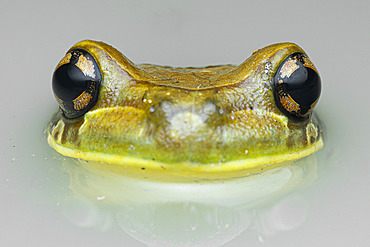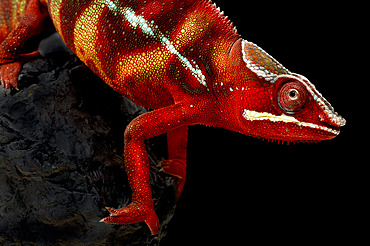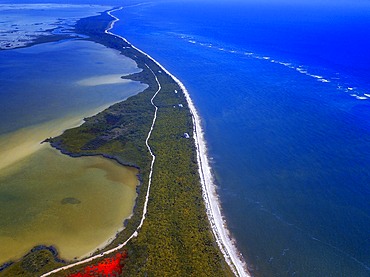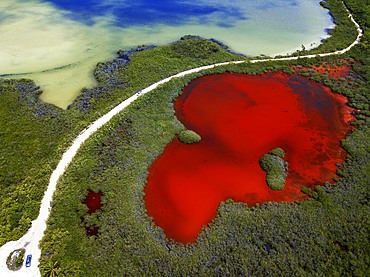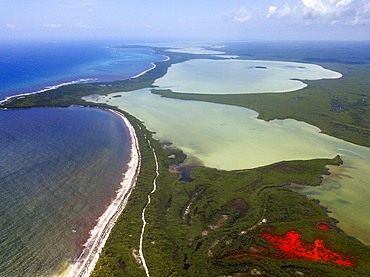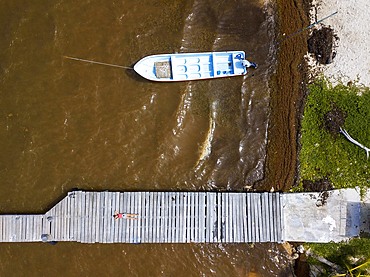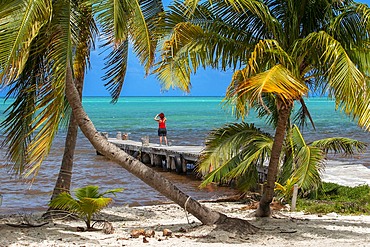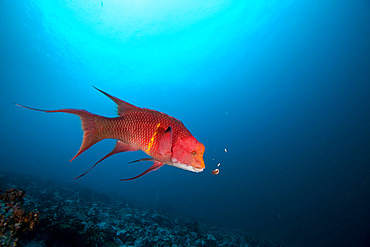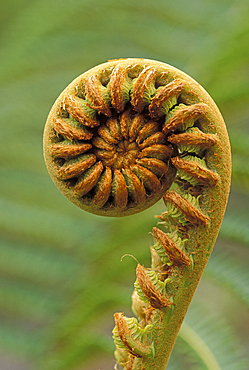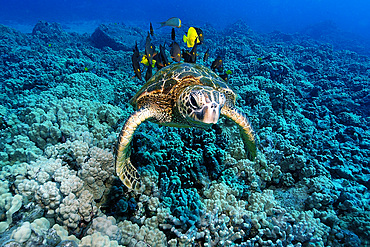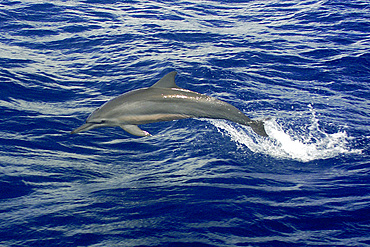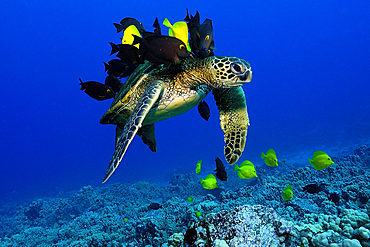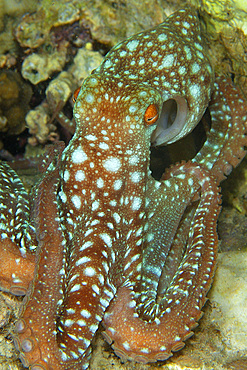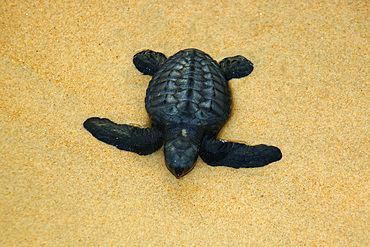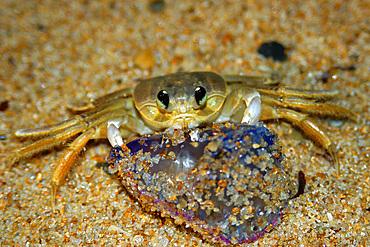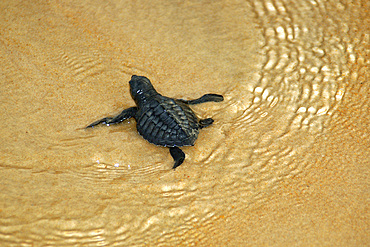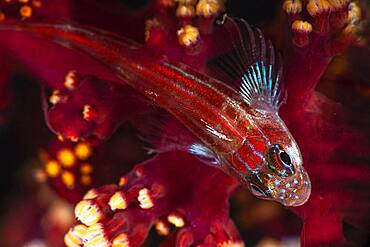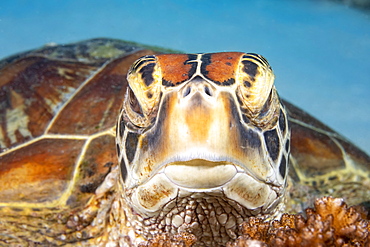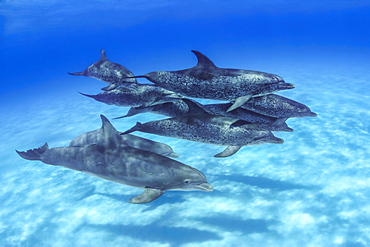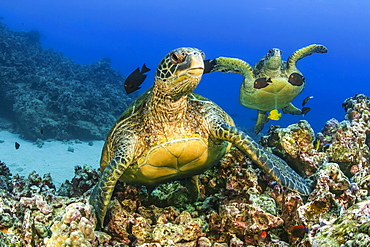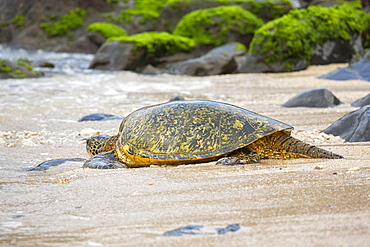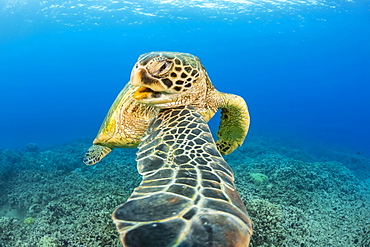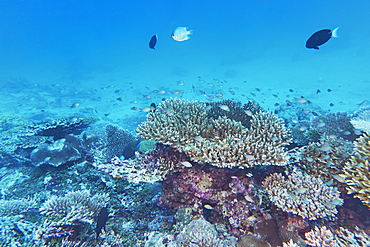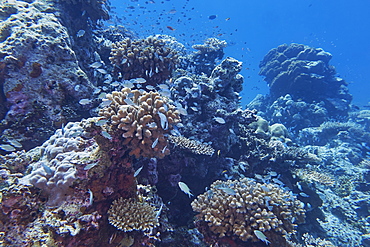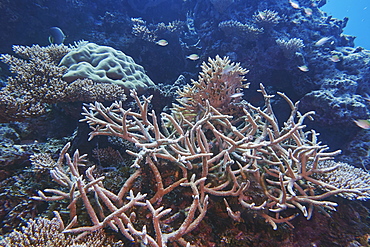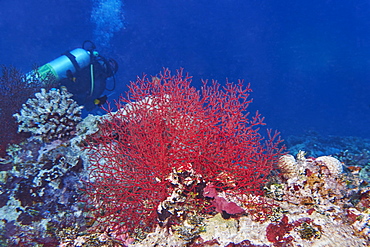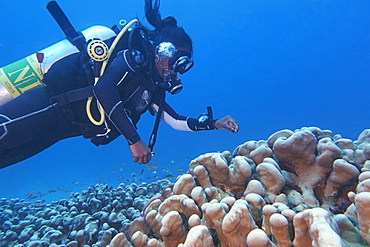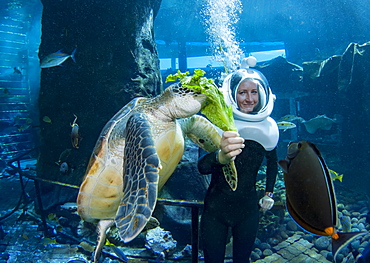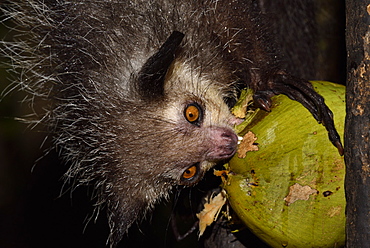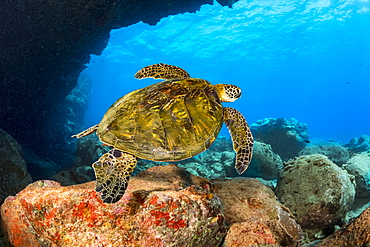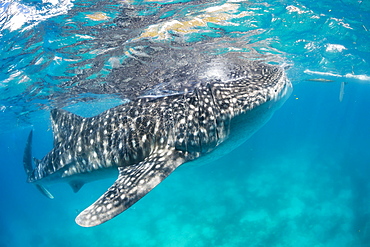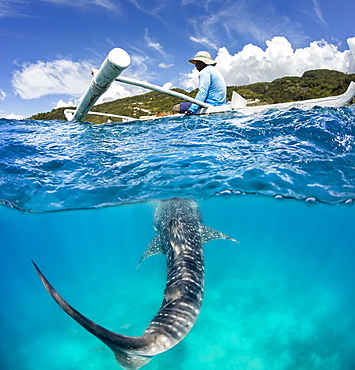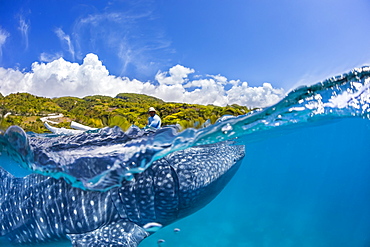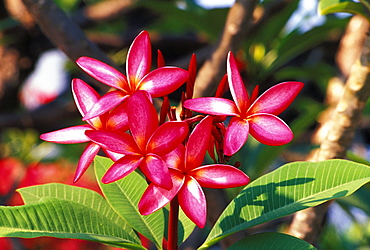Recent searches
Loading...
860-291986 - Amazon Basin Tree Snake (Imantodes lentiferus) Thin snake with big eyes, French Guyana
860-291983 - Mission Golden-eyed Treefrog (Trachycephalus resinifictrix) Kunawalu treefrog in a pond, Regina, French Guiana
860-291866 - Tropical greenhouse, Botanical Conservatory Garden of Brest, Finistere, Brittany, France
860-291624 - Tiny islet. A tiny islet with a single mangrove tree in the lagoon of Mayotte.
860-291549 - Panther chameleon (Furcifer pardalis) male.
860-291548 - Panther chameleon (Furcifer pardalis) male.
860-291433 - Fringe-lipped Bat (Trachops cirrhosus) in the hand of a scientist as part of a pollination study, tropical forest at the "La Selva" research station in Puerto Viejo de Sarapiqui, Costa Rica
1350-6627 - Aerial view of Punta Allen Sian Ka'an Reserve, Yucatan Peninsula, Mexico. Red lagoon near Boca Paila Bridge.
In the language of the Mayan peoples who once inhabited this region, Sian Ka'an means Origin of the Sky. Located on the east coast of the Yucatán peninsula, this biosphere reserve contains tropical forests, mangroves and marshes, as well as a large marine section intersected by a barrier reef. It provides a habitat for a remarkably rich flora and a fauna comprising more than 300 species of birds, as well as a large number of the region's characteristic terrestrial vertebrates, which cohabit in the diverse environment formed by its complex hydrological system.
Along its roughly 120 kilometres of coastline, the property covers over 400,000 hectares of land ranging from sea level to only ten m.a.s.l. The property boasts diverse tropical forests, palm savannah, one of the most pristine wetlands in the region, lagoons, extensive mangrove stands, as well as sandy beaches and dunes. The 120,000 hectares of marine area protect a valuable part of the Mesoamerican Barrier Reef and seagrass beds in the shallow bays. The lush green of the forests and the many shades of blue of the lagoons and the Caribbean Sea under a wide sky offer fascinating visual impressions.
1350-6623 - Aerial view of Punta Allen Sian Ka'an Reserve, Yucatan Peninsula, Mexico. Red lagoon near Boca Paila Bridge.
In the language of the Mayan peoples who once inhabited this region, Sian Ka'an means Origin of the Sky. Located on the east coast of the Yucatán peninsula, this biosphere reserve contains tropical forests, mangroves and marshes, as well as a large marine section intersected by a barrier reef. It provides a habitat for a remarkably rich flora and a fauna comprising more than 300 species of birds, as well as a large number of the region's characteristic terrestrial vertebrates, which cohabit in the diverse environment formed by its complex hydrological system.
Along its roughly 120 kilometres of coastline, the property covers over 400,000 hectares of land ranging from sea level to only ten m.a.s.l. The property boasts diverse tropical forests, palm savannah, one of the most pristine wetlands in the region, lagoons, extensive mangrove stands, as well as sandy beaches and dunes. The 120,000 hectares of marine area protect a valuable part of the Mesoamerican Barrier Reef and seagrass beds in the shallow bays. The lush green of the forests and the many shades of blue of the lagoons and the Caribbean Sea under a wide sky offer fascinating visual impressions.
1350-6625 - Aerial view of Punta Allen Sian Ka'an Reserve, Yucatan Peninsula, Mexico. Red lagoon near Boca Paila Bridge.
In the language of the Mayan peoples who once inhabited this region, Sian Ka'an means Origin of the Sky. Located on the east coast of the Yucatán peninsula, this biosphere reserve contains tropical forests, mangroves and marshes, as well as a large marine section intersected by a barrier reef. It provides a habitat for a remarkably rich flora and a fauna comprising more than 300 species of birds, as well as a large number of the region's characteristic terrestrial vertebrates, which cohabit in the diverse environment formed by its complex hydrological system.
Along its roughly 120 kilometres of coastline, the property covers over 400,000 hectares of land ranging from sea level to only ten m.a.s.l. The property boasts diverse tropical forests, palm savannah, one of the most pristine wetlands in the region, lagoons, extensive mangrove stands, as well as sandy beaches and dunes. The 120,000 hectares of marine area protect a valuable part of the Mesoamerican Barrier Reef and seagrass beds in the shallow bays. The lush green of the forests and the many shades of blue of the lagoons and the Caribbean Sea under a wide sky offer fascinating visual impressions.
1350-6620 - Aerial view of Punta Allen Sian Ka'an Reserve, Yucatan Peninsula, Mexico. Red lagoon near Boca Paila Bridge.
In the language of the Mayan peoples who once inhabited this region, Sian Ka'an means Origin of the Sky. Located on the east coast of the Yucatán peninsula, this biosphere reserve contains tropical forests, mangroves and marshes, as well as a large marine section intersected by a barrier reef. It provides a habitat for a remarkably rich flora and a fauna comprising more than 300 species of birds, as well as a large number of the region's characteristic terrestrial vertebrates, which cohabit in the diverse environment formed by its complex hydrological system.
Along its roughly 120 kilometres of coastline, the property covers over 400,000 hectares of land ranging from sea level to only ten m.a.s.l. The property boasts diverse tropical forests, palm savannah, one of the most pristine wetlands in the region, lagoons, extensive mangrove stands, as well as sandy beaches and dunes. The 120,000 hectares of marine area protect a valuable part of the Mesoamerican Barrier Reef and seagrass beds in the shallow bays. The lush green of the forests and the many shades of blue of the lagoons and the Caribbean Sea under a wide sky offer fascinating visual impressions.
1350-6616 - Aerial view of Punta Allen Sian Ka'an Reserve, Yucatan Peninsula, Mexico.
In the language of the Mayan peoples who once inhabited this region, Sian Ka'an means Origin of the Sky. Located on the east coast of the Yucatán peninsula, this biosphere reserve contains tropical forests, mangroves and marshes, as well as a large marine section intersected by a barrier reef. It provides a habitat for a remarkably rich flora and a fauna comprising more than 300 species of birds, as well as a large number of the region's characteristic terrestrial vertebrates, which cohabit in the diverse environment formed by its complex hydrological system.
Along its roughly 120 kilometres of coastline, the property covers over 400,000 hectares of land ranging from sea level to only ten m.a.s.l. The property boasts diverse tropical forests, palm savannah, one of the most pristine wetlands in the region, lagoons, extensive mangrove stands, as well as sandy beaches and dunes. The 120,000 hectares of marine area protect a valuable part of the Mesoamerican Barrier Reef and seagrass beds in the shallow bays. The lush green of the forests and the many shades of blue of the lagoons and the Caribbean Sea under a wide sky offer fascinating visual impressions.
1350-6615 - Palms and old pier in Punta Allen Sian Ka'an Reserve, Yucatan Peninsula, Mexico.
In the language of the Mayan peoples who once inhabited this region, Sian Ka'an means Origin of the Sky. Located on the east coast of the Yucatán peninsula, this biosphere reserve contains tropical forests, mangroves and marshes, as well as a large marine section intersected by a barrier reef. It provides a habitat for a remarkably rich flora and a fauna comprising more than 300 species of birds, as well as a large number of the region's characteristic terrestrial vertebrates, which cohabit in the diverse environment formed by its complex hydrological system.
Along its roughly 120 kilometres of coastline, the property covers over 400,000 hectares of land ranging from sea level to only ten m.a.s.l. The property boasts diverse tropical forests, palm savannah, one of the most pristine wetlands in the region, lagoons, extensive mangrove stands, as well as sandy beaches and dunes. The 120,000 hectares of marine area protect a valuable part of the Mesoamerican Barrier Reef and seagrass beds in the shallow bays. The lush green of the forests and the many shades of blue of the lagoons and the Caribbean Sea under a wide sky offer fascinating visual impressions.
1350-6678 - Strawberry Poison Frog (Dendrobates pumilio), adult, Bastimentos National Park, Bocas del Toro, Panama. The strawberry poison frog or strawberry poison-dart frog (Oophaga pumilio or Dendrobates pumilio) is a species of small amphibian poison dart frog found in Central America. It is common throughout its range, which extends from eastern central Nicaragua through Costa Rica and northwestern Panama. The species is often found in humid lowlands and premontane forest, but large populations are also found in disturbed areas such as plantations. The strawberry poison frog is perhaps most famous for its widespread variation in coloration, comprising approximately 15���30 color morphs, most of which are presumed to be true-breeding. O. pumilio, while not the most poisonous of the dendrobatids, is the most toxic member of its genus. The species is most diverse in Panama with varieties in vivid shades of all red, orange, blue, yellow or green, green and yellow, white with red, orange or black and spotted varieties. The most colorful mix is found in Isla Bastimentos Marine National Park though not all in one place. Colors vary by location. A beach on the north side of the island is named after the species. Two of Southern Explorations' Panama tours visit red frog habitat. Both the eight-day Panama Adventure trip and eleven-day Panama Highlights trip spend time in Isla Bastimentos Marine National Park and the former also goes to Red Frog Beach.
The red frog is not as poisonous as some of its cousins and is not a threat to humans. It subsists on a diet of ants that dine on poisonous plants, providing the red frog its protective skin toxin. Males attract females with a loud quick chirp. To hear the distinctive sound before you depart on your Panama tours, go to the University of Michigan Museum's biodiversity website (www.animaldiversity.ummz.umich.edu.) After birth, the tadpoles climb aboard the mother who deposits them in different protected areas where she retu
860-290470 - Splendid pitcher-plant (Nepenthes edwardsiana) urn
1350-6347 - Red Ti leaves; National Tropical Botanical Garden - McBryde Garden, Lawai, Kauai, Hawaii.
1350-6281 - School of lionfish (Pterois sp.) in the tropical waters of Misool, Indonesia
860-289986 - Mexican hogfish (Bodianus diplotaenia) feeding on barnacles in the Wildlife Sanctuary of Malpelo Island, Colombia.
860-290383 - Calderon tropical (Globicephala macrorhynchus) with scars and scratches caused by interactions between individuals of the same species, although so many marks are not common. Tenerife, Canary Islands.
1350-2428 - Green sea turtle, Chelonia mydas, Kailua-Kona, Hawaii, (Pacific)
1350-2957 - Red Ti leaves; National Tropical Botanical Garden - McBryde Garden, Lawai, Kauai, Hawaii.
1350-2574 - Beaked Whale stranded on coral reef during low tide, Mesoplodon sp., Mili, Marshall Islands (N. Pacific)..
1350-3164 - 'Ama'uma'u fern fiddlehead (Sadleria cyatheoides); endemic to Hawaii.
1350-2427 - Green sea turtle, Chelonia mydas, gets cleaned by yellow tangs, Zebrasoma flavescens and lined bristletooth, Ctenochaetus striatus, Kailua-Kona, Hawaii, (N. Pacific)
1350-2449 - Spinner dolphin, Stenella longirostris, Namu atoll, Marshall Islands (N. Pacific).MID0042
1350-2426 - Green sea turtle, Chelonia mydas, gets cleaned by yellow tangs, Zebrasoma flavescens and lined bristletooth, Ctenochaetus striatus, Kailua-Kona, Hawaii, (N. Pacific)
1350-2534 - Starry night octopus, Octopus luteus, foraging on coral reef at night, Malapascua, Cebu, Philippines, Visayan Sea.
1350-2318 - Olive ridley turtle hatchling, Lepidochelys olivacea, Costa do Sauipe, Bahia, Brazil (South Atlantic)
1350-2316 - Crab preying on dead portuguese man-of-war, Physalia physalis, Praia do Forte, Bahia, Brazil (South Atlantic)
1350-2317 - Olive ridley turtle hatchling, Lepidochelys olivacea, Costa do Sauipe, Bahia, Brazil (South Atlantic)
1350-2314 - Green sea turtles hatching, Chelonia mydas, Fernando de Noronha, Pernambuco, Brazil.
860-289000 - Tropical striped triplefin (Helcogramma striatum), Raja Ampat, Indonesia
1116-49665 - A close look into the eyes of a Green sea turtle (Chelonia mydas), an endangered species, Philippines
1116-49706 - Mr. Fleetham spent an afternoon photographing these Atlantic Spotted Dolphin (Stenella plagiodon). During the several hours in the water a group of Atlantic Bottlenose Dolphin (Tursiops truncates) joined the company for nearly an hour of inter-species exchange, Bahamas
1116-49715 - Green sea turtles (Chelonia mydas), an endangered species, Hawaii, United States of America
1116-49671 - Research divers from the MOC Marine Institute map out coral damage at Molokini Marine Preserve off the island of Maui, Hawaii. In the future, data from here will help to determine the health of Hawaii's reefs, Maui, Hawaii, United States of America
1116-49664 - Although rarely seen in the ocean by divers, the Sandbar shark (Carcharhinus plumbeus) is likely the most numerous of all shark species found in Hawaii. This individual was photographed at the Maui Ocean Center Aquarium, Maui, Hawii, United States of America
1116-49673 - Research divers from the MOC Marine Institute glue broken coral heads back together and map out coral damage at Molokini Marine Preserve off the island of Maui, Hawaii. In the future, data from here will help to determine the health of Hawaii's reefs, Maui, Hawaii, United States of America
1116-49661 - A Green sea turtle (Chelonia mydas), an endangered species, makes it’s way from the beach back into the Pacific Ocean, Maui, Hawaii, United States of America
1116-49660 - Encounters with Hawaiian monk seals (Monachus schauinslandi) (endemic and endangered) are few and far between. Here a monk seal shares a patch of sand with a Green sea turtle (Chelonia mydas), also an endangered species, off Maui, Maui, Hawaii, United States of America
1116-49717 - The Mantis shrimp (Odontodactylus scyllarus) is also known as a clown mantis shrimp and peacock mantis shrimp, Cebu, Philippines
1116-49662 - This Green sea turtle (Chelonia mydas), an endangered species, is rubbing it's chin on it's shoulder, Hawaii, United States of America
1202-463 - A mix of Acropora species hard corals, on a tropical coral reef, around Gaafu Dhaalu atoll, in the south of The Maldives, Indian Ocean, Asia
1202-466 - Small reef fish crowd around outcrops of Pocillopora species hard corals, a coral reef in Gaafu Dhaalu atoll, The Maldives, Indian Ocean, Asia
1202-465 - A mix of Acropora species hard corals, on a tropical coral reef, around Gaafu Dhaalu atoll, in the south of The Maldives, Indian Ocean, Asia
1202-470 - A gorgonian sea fan (possibly Echinogorgia species) octocoral on a tropical coral reef, in Gaafu Dhaalu atoll, The Maldives, Indian Ocean, Asia
1202-464 - A diver around a Stylophora species hard coral, on a tropical coral reef, in Gaafu Dhaalu atoll, The Maldives. Indian Ocean, Asia
1116-48649 - The Peacock Grouper (Cephalopholis argus) was deliberately introduced to Hawaii and is now considered an invasive species, Island of Hawaii, Hawaii, United States of America
1116-48645 - This gold dust day gecko (Phelsuma laticauda) resting on a palm tree was photographed on the Kona coast of the Big Island, Hawaii, where it is an introduced species, Island of Hawaii, Hawaii, United States of America
1116-46942 - Close-up of a beautiful mixed pink Heliconia flower against a green leaf, Honolulu, Oahu, Hawaii, United States of America
1116-46941 - A macro close-up of a beautiful orange and yellow Heliconia flower against a white background, Honolulu, Oahu, Hawaii, United States of America
1116-46834 - This trumpetfish (Aulostomus chinensis) is traveling over a reef between the fins of a green sea turtle (Chelonia mydas), an endangered species, in an attempt to ambush an unsuspecting fish, Maui, Hawaii, United States of America
1116-46823 - A diver feeds a green sea turtle (Chelonia mydas), an endangered species, at Sea Life Park's Underwater Sea Trek Adventure in their big tank, Oahu, Hawaii, United States of America
860-287853 - Aye-aye (Daubentonia madagascariensis) in the forest at night, under the tropical rain, eating a coconut, Pangalanes Canal, Ampitabe Lake, Atsinanana Region, Madagascar
860-287852 - Aye-aye (Daubentonia madagascariensis) in the forest at night, under the tropical rain, eating a coconut, Pangalanes Canal, Ampitabe Lake, Atsinanana Region, Madagascar
860-287851 - Aye-aye (Daubentonia madagascariensis) in the forest at night, under the tropical rain, eating a coconut, Pangalanes Canal, Ampitabe Lake, Atsinanana Region, Madagascar
860-287850 - Panther Chameleon (Furcifer pardalis) male portrait, Pangalanes Canal, Ampitabe Lake, Atsinanana Region, Madagascar
860-288283 - Lowland tropical dwarf bullfrog (Leptodactylus andreae)
860-287845 - Cuvier's Madagascar Swift (Oplurus cuvieri) in Tropical Rainforest, Pangalanes Canal, Ampitabe Lake, Atsinanana Region, Madagascar
860-287828 - Fiery Bright-eyed Frog (Boophis pyrrhus) in tropical forest, Pangalanes Canal, Ampitabe Lake, Atsinanana Region, Madagascar
860-287848 - Mahanoro Digging Frog (Plethodontohyla notosticta) in its tree hole with his tadpoles in Tropical Rainforest, Pangalanes Canal, Ampitabe Lake, Atsinanana Region, Madagascar
1116-41504 - A green sea turtle (Chelonia mydas), an endangered species, surfaces for a breath in front of a stand-up paddle board off the coast of Maui, Maui, Hawaii, United States of America
1116-41399 - This green sea turtle (Chelonia mydas), an endangered species, is passing under Lone Tree Arch, a dive site on the Kona Coast, Kona, Island of Hawaii, Hawaii, United States of America
1116-39726 - The Bubble Coral Shrimp (Vir philippinensis) is found only on this species of coral, Pleurogyra sinuosa. The brown oval objects are actually Acoel Flatworms (Waminoa sp) that feed on nutrients trapped in mucus covering the coral, Philippines
1116-39732 - This species of coral hermit crab (Paguritta sp) is well known, but still awaiting a name from biologists. It lives in a hole in hard coral and traps passing plankton in it's feathery antennae, Yap, Micronesia
1116-39714 - These two parasitic mollusks, Thyca crystallina, are growing on the host starfish, Linckia laevigata. This parasitic shell only attaches to this species of starfish, into which it burrows and sucks up nutrients, Philippines
1116-39963 - Tourists above on a canoe and a Whale Shark (Rhiniodon typus) below with it's mouth open. This is the world's largest species of fish, Oslob, Philippines
1116-39711 - The Blacktail Snapper (Lutjanus fulvus) reach 13 inches in length and feed mostly on small fish and crabs. This is one of several species that were sucessfully introduced to Hawaii, Hawaii, United States of America
1116-39967 - A commercial whale shark encounter with a feeder above on a canoe and a Whale Shark (Rhiniodon typus) below. This is the world's largest species of fish, Oslob, Philippines
1116-39965 - A Whale Shark (Rhiniodon typus) with it's mouth open, filter feeding at the surface. This is the world's largest species of fish, Oslob, Philippines
1116-40060 - Milletseed Butterflyfish (Chaetodon citrinellus) feeding on plankton off Ni'ihau Island near Kauai, Hawaii, USA during the spring. This fish species is endemic to the Hawaiian Islands, Kauai, Hawaii, United States of America
1116-39964 - A commercial whale shark encounter with a feeder above on a canoe and a Whale Shark (Rhiniodon typus) below. This is the world's largest species of fish, Oslob, Philippines
1116-39703 - Green sea turtle (Chelonia mydas), an endangered species, is resting under a fan of gorgonian coral along with two remora, Philippines
1116-39725 - Mouth detail of a colourful and healthy Mushroom coral, Fungia fungites, that is growing on a tropical coral reef in the Philippines. Mushroom coral is unique in the coral world, in that it does not attach itself to the bottom, Philippines
1116-39702 - Green sea turtle (Chelonia mydas), an endangered species, in an underwater crevice off West Maui, Maui, Hawaii, United States of America
1116-39704 - Green sea turtles (Chelonia mydas), an endangered species, gathering at a cleaning station off Maui, Maui, Hawaii, United States of America
1116-39730 - Colourful coral reef and schooling fish, Hawaii, United States of America
1116-39719 - A Slender Spongegoby (Phyllogobius platycephalops) and two different species of crabs. Attached to the goby are several parasites with egg cases, that will likely prove fatal over time. Many species live on the convuluted surface of this sponge, Philippin
1116-39758 - Diver and schooling Yellowfin Goatfish (Mulloidichthys vanicolensis). This species turns red at night and when they are in caves during the day, Kauai, Hawaii, United States of America
1116-39966 - A commercial whale shark encounter with a feeder above on a canoe and a Whale Shark (Rhiniodon typus) below. This is the world's largest species of fish, Oslob, Philippines
1116-39950 - Bumphead parrotfish (Bolbometopon muricatum) are the largest species in this family and can reach 5 feet in length and over 160 pounds, Yap, Micronesia
1116-39938 - Mouth detail of a colorful and healthy mushroom coral (Fungia fungites) that is growing on a tropical coral reef. Mushroom coral is unique in the coral world, in that it does not attach itself to the bottom, Philippines
860-282491 - Soft corals on a tropical reef, Raja Ampat Indonesia
869-5869 - orang utan hanging over brook playing (Pongo pygmaeus)
832-353851 - Colourful flowerbed planted with various summer flowers, Cardinal Flower (Lobelia fulgens), Scarlet Sage or Tropical Sage (Salvia splendens), Flossflower or Bluemink (Ageratum houstonianum)
832-138067 - Orchid, orchid garden, Tropical Garden, Jardim Tropical Monte Palace, Jose Bernardo Foundation, Funchal, Madeira, Portugal, Europe
817-429623 - Diver and Blackspotted rubberlip Plectorhinchus gaterinus, Red Sea, Egypt, Africa
817-429627 - Red soft coral, Labuan Layang Layang, Red Sea, Egypt, Africa
817-410339 - Olive baboon, Papio Anubis, Olive baboons are widespread throughout equatorial Africa and are found in 25 countries. From the west coast of Africa moving eastward. In the picture there is a mother with a juvenile, the mother is eating some grass and the s. Olive baboon, Papio Anubis, Olive baboons are widespread throughout equatorial Africa and are found in 25 countries. From the west coast of Africa moving eastward. In the picture there is a mother with a juvenile, the mother is eating some grass and the small one is in its back. In Uganda, olive baboons live in open woodland bordered by savannah and in evergreen tropical forests At Queen Elizabeth National Park, situated in Uganda, near the border of Democratic Republic of Congo, the habitat is characterized by dense forest, coarse wet grass, short grass and open grassland. Olive baboons consume a wide variety of foods and they can adapt to very different kind of habitats, from desert to mountain forest because they have many different strategies and habilities to extract food and nutrients. Baboons are omnivores and consume a huge variety of vegetables, insects, birds, eggs, and vertebrates including other primates. The Olive Baboon is one of the largest baboons, with the males being larger than the females. Their body length is 60, 86 cm, their tail length is 41, 58 cm and they weigh between 22 and 37 Kg. There is some geographical variation in average size. They have an olive green/grey coat that covers their bodies and a black face. The males have large canine teeth where as the teeth of females are much smaller. They move around on all four limbs. They live in troops of males and females that consist of between 20 and 50 members. The picture was taken in Ugande, in the Queen Elizabeth National Park, near the Kazinga channel., Uganda, Africa, East-africa
1113-20170 - Green Turtle, Chelonia mydas, Oahu, Pacific Ocean, Hawaii, USA
1116-30333 - Hawaii, Maui, Humpback whale breaching with island in the background.
1116-30336 - Hawaii, Maui, Humpback whale breaching with island in the background.
1116-30932 - Hawaii, galapagos shark with sunburst in background, (Carcharhinus galapagensis).
1116-35601 - Thailand, Cha-am, close-up pink plumerias on branch
1116-30318 - Hawaii, Maui, Humpback whale fluking its tail.
1116-28361 - Hawaii, Maui, A reef manta ray, (Manta alfredi) cruises over the shallows off Ukumehame.

